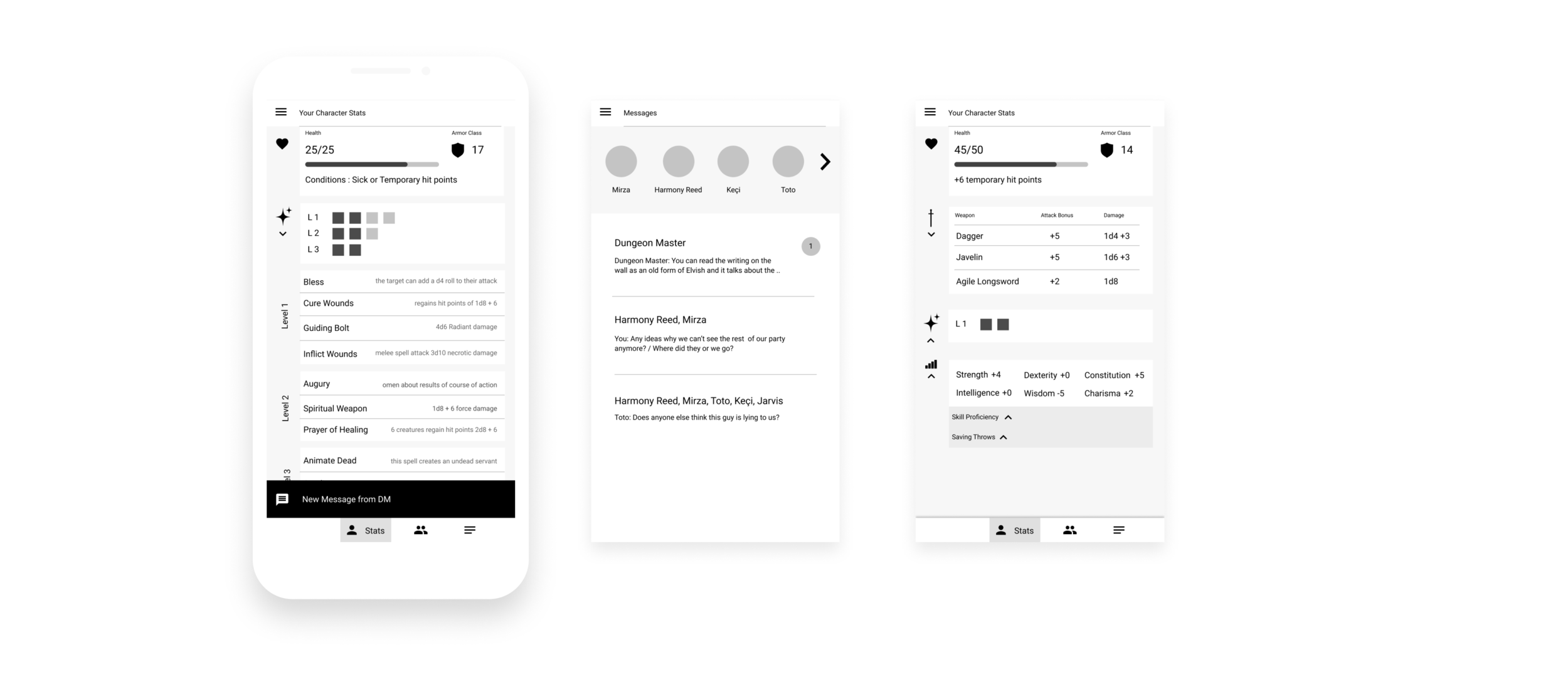Hierarchy
of informationDungeons & Dragons
A Dungeons and Dragons app that is primarily designed to encourage role playing and intrigue
User stories
Product goals
This app is suitable for users who have never played before. The app should make playing DnD easy for everyone.
Designed for intrigue campaigns although helpful for dungeon crawlers as well, this app helps the DM control information and encourage roleplay. Player-available information is designed to keep them engaged in the gameplay moment by offloading requirements to remember things or pretending to have the same information as their character.
Working as a team should be as easy as possible. This app gives all the information players need about their teammates in order to coordinate team play.
Pen and paper game
The icons
Using icons helped to organize all of the words that are on a character sheet. It is easier and less intimidating for new users to scan images and then open up the section to read, than to have to sift through all of the text.
Information cards
In the character sheet
The most important information for a player to have on hand depends on the type of character they are playing. There is no one-size-fits-all format. In order for the user to have the information they want most accessible to them, the information is contained in rearrangeable cards. The user gets to decide in what order their cards appear and can expand or collapse them. This gives the user ample flexibility to keep track of their characters, and has the added benefit of being agnostic towards homebrew or other RPG systems than 5e.
Taking notes
Games have the potential to go on for a really long time. It is standard practice to take notes while playing the game because important names or locations might not be mentioned for months. Within the note section, players can make cards for any person, place, or thing that they learn about during the game. These cards are communal, so every player has access to view or edit information.
Two new features from user stories
The "Player" and "DM" user stories resulted in two new features that are not in any other DnD app. Viewing other player's stats and a private chat between DM and individual players encourages a game play that is focused on the group and the individual player's role in the group.
Keeping track of the group
View your teammates basic stats
To help players work better as a team, they can see things which they could be reasonably be expected to know about the rest of the group just by looking at them or from traveling with them for months. Their armor, weapons, health, spells, and backstory are all available to the rest of the party.
The DM has the added feature of being able to control who can see who. This feature can be used to mimic the environment, such as if the party is split into two different rooms of a cave. In such a scenario, players can only see the stats of those who are in the same room with them. If they all split up, they can’t see each other at all.
The Player’s View as Adeline, can see the stats of Mirza and Harmony Reed because the DM has put them in the same group.
Control who gets to know
DM to Player chat
In an intrigue or role playing heavy game, the DM to Player chat is a tool for the DM to encourage role playing and intrigue within the game.
For example, if only two of the characters know Elvish, this is a way for the DM to reveal information in Elvish only to them, or if a character is charmed, the player can actually role play being charmed instead of players having to pretend they don’t know their teammate is under certain influence.
The players then can decide if their characters are going to reveal what they have learned, or keep it to themselves. This allows for more genuine role playing. It can be difficult as a player to not let things “you as a player know” vs. “what your character knows” affect the decisions you make for your character.
For the DM, this is basically a more elegant version of passing notes. Players are discouraged from making use of this during regular play, but the situation may arise, so the feature is left in but hidden within their menu.






